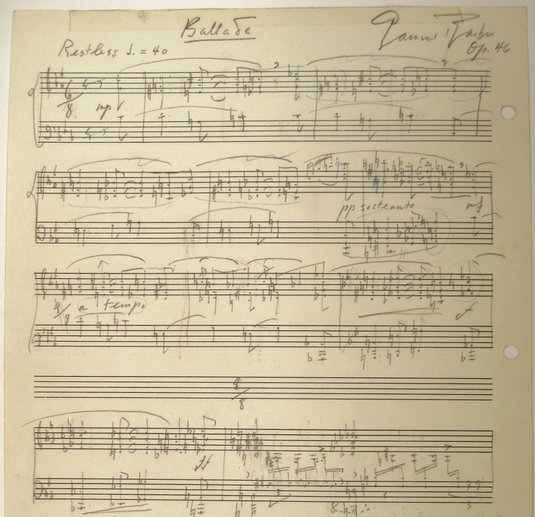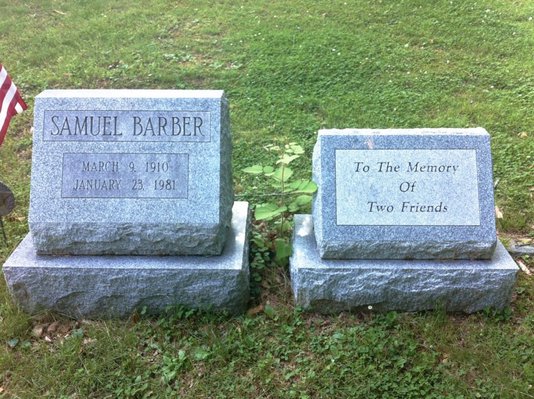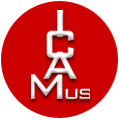Samuel Barber Complete Thematic Catalogue - Sibelius SCORCH files for Chapter 7. 1970-1981: The Last Years.
Barber's score incipits for all the works composed in last years. Samuel Barber: A Thematic Catalogue of the Complete Works by Barbara B. Heyman, published by Oxford University Press; in the volume, all excerpts from the published and unpublished works of Samuel Barber are reprinted by permission of G. Schirmer, Inc., and the Samuel Barber Trust. Sibelius SCORCH files for Chapter 7: Works 1970-1981 (H-140 to H-146). This section includes the last pieces that Barber completed, among which the Ballade for piano and the Third Essay for Orchestra.

View and listen to the score incipits and relevant Sibelius SCORCH audio files of Samuel Barber’s Thematic Catalogue. The Table of Contents and the Index Numbers refer to Samuel Barber: A Thematic Catalogue of the Complete Works by Barbara B. Heyman (Oxford University Press, 2012). This online publication is an innovative ICAMus project carried out by special arrangement with Dr. Heyman and with the Publisher. Barbara Heyman is the author of Samuel Barber: The Composer and His Music (Oxford University Press, 1992).
* Note. If you are unable to view the Sibelius SCORCH files, please install the plug-in here. It is free and easy. The plug-in allows you to view and listen to the score incipits of Samuel Barber’s Thematic Catalogue, inclusive of all his early, rare, unpublished and incomplete compositions. The Sibelius score incipit for each work follows the title it refers to.
SAMUEL BARBER (1910-1981)
REGISTER OF INCIPITS
PART 7 (1970-1981) H-140 to H-146
H-140 Variation on "Happy Birthday". For brass choir and timp.; 1969.
H-141 The Lovers, Op. 43. Text from Pablo Neruda (1904-1973) traslated by W.S. Merwin, Christopher Logue and Samuel Barber with Valentin Herranz, arranged by Samuel Barber. For chorus with soloists and orchestra, in 10 movements; 1971.
a. Prelude. For orchestra.
b. Body of a woman, I. For baritone solo.
c. Lithe girl, brown girl, II. For men's chorus and a few women's voices, and orchestra.
d. In the hot depth of this summer, III. For women's voices, and orchestra.
e. Close your eyes, IV. For full chorus and orchestra.
f. The Fortunate Isles, V. For full chorus with incidental soprano solo, and orchestra.
g. Sometimes, VI. For baritone solo and orchestra.
h. We have lost even this twilight, VII. For full chorus and orchestra.
i. Tonight I can write the saddest lines, VIII. For baritone solo and orchestra.
j. Cemetery of kisses, IX. For mixed chorus and orchestra.
H-142 Fadograph of a Yestern Scene, Op. 44. For orchestra; 1971.
H-143 Three Songs, Op. 45. For voice and piano (originally for low voice and piano); 1972.
a. Now have I fed and eaten up the rose, Op. 45, No. 1. Text from Gottfried Keller (1819-1890) in a translation from the German by James Joyce (1882-1941) based on an abbreviated version.
b. A Green Lowland of Pianos, Op. 45, No. 2. Text by Jerzy Harasimowicz (1933-1999) trans. from the Polish by Czeslaw Milosz.
c. O Boundless, Boundless Evening, Op. 41, No. 3. Text by Georg Heymn (1887-1912) trans. from the German by Christopher Middleton.
H-144 Ballade, Op. 46. For piano; 1977.
H-145 Third Essay, Op. 47. For orchestra; 1978.
Opening
Melodic articulation of opening
Main theme
H-146 Canzonetta for Oboe and String Orchestra, Op. 48. Incomplete at the time of Barber's death; orchestrated by Charles Turner. Posthumous work; 1978-1981.

SAMUEL BARBER - THEMATIC CATALOGUE INDEX:
PART 1
Samuel Barber Complete Thematic Catalogue - Sibelius SCORCH files for Chapter 1. Childhood.
Earliest Works, 1917-1923 (H-1 to H-19). This section includes the first compositions Samuel Barber wrote as a child.
PART 2
Samuel Barber Complete Thematic Catalogue - Sibelius SCORCH files for Chapter 2. Adolescence.
Works 1924-1929 (H-20 to H-58). This section includes the compositions Samuel Barber wrote as a teenager.
PART 3
Earliest Works, 1930-1939 (H-59 to H-94). This section includes the pieces Samuel Barber wrote in his youth.
PART 4
Works 1940-1949 (H-95 to H-117). This section includes the pieces Samuel Barber wrote in his thirties, among which the Capricorn Concerto Op. 21, the Concerto for Violoncello and Orchestra Op. 22, and the Piano Sonata Op. 26.
PART 5
Works 1950-1959 (H-118 to H-129). This section includes the pieces Samuel Barber wrote in his more mature years, among which Hermit Songs Op. 29, and the opera Vanessa, to a libretto by Gian Carlo Menotti.
PART 6
Works 1960-1969 (H-130 to H-139). This section includes the pieces Samuel Barber wrote over a decade, among which the Piano Concerto Op. 38, and the opera Antony and Cleopatra, to a libretto adapted from Shakespeare by Franco Zeffirelli.
PART 7
Samuel Barber Complete Catalogue - Sibelius SCORCH files for Chapter 7. 1970-1981: The Last Years.
Works 1970-1981 (H-140 to H-146). This section includes the last pieces that Barber completed, among which the Ballade for piano and the Third Essay for Orchestra.
PART 8
Samuel Barber Complete Catalogue - Sibelius SCORCH files for Chapter 8. Unidentified Fragments.
Unidentified Manuscripts (H-U1 to H-U8). This section includes holograph sketches and fragments from different time periods of the composer's career.
Please note: All of our Barber website pages include a direct link to install the plug-in for viewing and playing the music incipits. Plug-in installation is free and very easy. Installation and fruition of Sibelius Scorch may feature differently on different operating systems and browsers, and various versions of them. For system requirements and full compatibility information, please read this.

